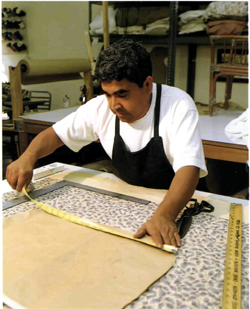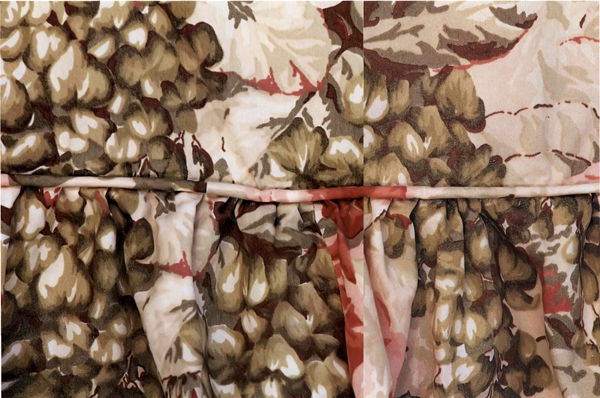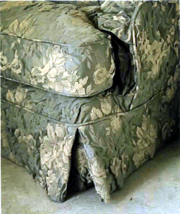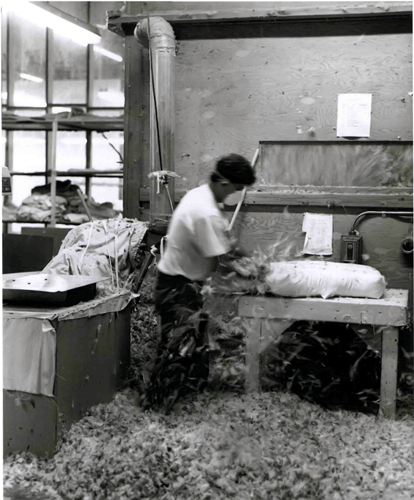

Wicker—especially painted white—has long been a favorite material for outdoor furniture, due to its loose weave and easy portability. On Tony and Donna Scott’s patio is an old convent bench that appears to be comprised of seven chairs fastened together. Its unusual length and comfortable striped cushion make it the perfect spot for a lazy afternoon nap for people and dogs alike. The cool stone walls and bougainvillea overhead add to the shady mood.
Because sofas and chairs are the most important functional pieces in most of our living spaces, I want to give them special attention in this book. Although slipcovers are my first choice for chairs and sofas, leather and wicker are also materials that work well to create the Shabby Chic look. Leather is appealing because it is timeless, classic, natural, comfortable, and ages beautifully. I love wicker because it is lightweight, can be used indoors or outdoors, comes in an array of weaves, and can add an aura of casualness to otherwise formal surroundings.
If a leather piece is simply too worn, with distracting bare patches or scratches, parts of it can be reupholstered inexpensively without ruining the antique look of the whole. A different fabric can even be brought in to save money. I have replaced the worn leather cushion of an armchair with a velvet one, which added a new texture, cut down on cost, yet kept the piece plush. Wicker, though it can be costly to restore, is easy to repaint and has the uncanny ability to fit into a variety of different environments. (For more on wicker, see Chapter 3, “Hidden Treasures and Inspirations.”)
When considering both the appeal and function of sofas and chairs, shape, size, and fabrics, and the wav the pieces are placed in a room are all important elements. A chair meant for reading should be comfortable but not so cushy that it induces sleep, and it should of course be placed near good lighting. A chair for dining or the home office should be upright to facilitate eating or studying. Chairs meant for socializing should be comfortable and arranged in a way that promotes communication by minimizing the need to crane one’s neck or raise one’s voice to be heard. Seating meant for relaxing and napping, such as body pillows, poufs, chaises, and some armchairs, should be cushy, comfortable, soft, and oversized—my favorite look. All these points may seem obvious, but it’s amazing how many stiff, upright chairs I’ve seen that were intended by their owners to be comfortable and inviting.

This worn leather chair in Philomena Giusti’s home is marked by years of loving use. The faded patches and scratched studs make the chair an inviting sanctuary for one to curl up in and read. The original cushion, which became too tattered, was replaced with a velvet one. A silk pillow adds extra color and comfort.
Simply expanding the dimensions of a chair can give it a whole new function, like this extra-roomy slipcovered chaise. (See Resource Guide.)
In the case of sofas and chairs, need should dictate form. My children have inspired many of the chairs I’ve designed. An upholstered rocking chair was born after observing their love of rhythmic movement (although I installed a long wicker bench that resists rocking on one side of my dining room table, as the temptation for a child to rock while eating is just too great). I have also made arms on certain chairs rounder or bigger, backs straighter or more relaxed, depending on the intended use for a particular chair. Personal tastes can account for fabric choice, though for seating I suggest casual fabrics that can stand up to wear.
Ottomans or footstools not only elongate a chair by adding foot room, they also offer additional, casual seating in their own right and can add new colors, textures, and patterns to a room. Pillows are another way of bringing in color, detailing, and comfort to existing seating. Pillows are also very versatile—they can be contrasting or complementary, plain or detailed—and they are relatively inexpensive. If large enough, pillows can even be scattered on the floor and used as casual seating.
Slipcovered furniture is at the heart of the Shabby Chic style. Slipcovers can be made to look sleek or frilly, fancy or plain, depending upon the fabric and whether it has detailing, such as ruffles or welts (see Chapter 4, “Fabrics”). Myriad fabric and detail choices, ease of care, and their homey look make slipcovers my primary choice for new or old furniture.
Slipcovers are washable, so they offer the utmost in convenience and practicality. Like blue jeans or sweatshirts, slipcovers become more cozy and individual with each washing, and allow furniture to be lived on rather than merely looked at, to be used freely rather than cautiously. Marked by the feeling of being handed down and touched by the factors of real life—dog hairs, a spilled glass of wine, an ink stain accidents are taken in stride when they happen on a washable slipcovered sofa. If a stain doesn’t come out, you can add a throw or pillow, or replace the damaged panel with a new piece of the same fabric. If I have trouble finding the same fabric, I often use a completely different fabric, but along with replacing the damaged panel, I balance out the look by adding the new fabric to other parts of the chair or sofa as well.

When cutting fabric for a chair like the upholsterer is doing, the fitting is crucial. I prefer oversized slipcovers to allow for extra tucking, but sometimes, as in the case of more modern, streamlined furniture shapes, a tight fit is more appropriate.

When slipcovering a chair, the chair is measured first. Then, like an haute couture gown, the fabric is custom-cut to size. Once cut, the fabric is pin-fitted to the chair to make sure it fits, then removed and sewn into a slipcover, like this one at an upholsterer’s.

This is the type of squashy, floppy sofa I love. I call this one of matte lassé the Squadgey because it’s so cushy and enveloping. When washed, the texture of the slipcover becomes even more inviting.

The quintessential Shabby Chic sofa with smooshy feather-down seats.
Today, slipcovers are not limited to just cotton or denim. When I first started my business, a washable slipcover made of a classic upholstery fabric such as velvet or chenille was almost unheard of. Now there are an array of fabrics that not only can be washed but that gain a whole new desirable texture and character as a result. After washing, damasks become more two-dimensional or puckered, chenilles gain a relaxed feel, and chintzes lose their stiff glean and become smooth. But not every material is conducive to laundering, however. Running embossed velvets or moirés through a washing machine can ruin their delicate patterns. And shrinkage is something to be aware of when measuring your fabric. Avoid laundering colors such as deep blues and bright reds as they tend to run.
If you have trouble finding a fabric in the exact color you want, you can always experiment with dyeing your own at home. An inexpensive way to obtain a color you can’t find elsewhere is to buy a cotton sheet and some fabric dyes from the drugstore, experiment with small amounts of material and dye before you actually work with the sheet. Once you achieve the color you’re after, you can have the sheet fashioned into a slipcover.
Other ways to save money on slipcovering include mixing pricier fabrics with less expensive ones. The more visible back cushions, arms, and skirt of a chair or sofa can be covered in a silk-screened floral print for a hundred dollars a yard, while the seat cushions, back, and sides can be covered in a white denim for fifteen dollars a yard. The resulting look is a comfy, quiltlike look.
Another advantage to slipcovered furniture is that it does not lock you into one look all year round. You can have two different sets of slipcovers—a denim or cotton for summer, and velvet, chenille, or damask for winter. Having two sets is also convenient when your slipcovers are being laundered: You’re never stuck with bare furniture though you might want to consider whether the upholstery underneath the slipcovers is something you can live with while the covers are being washed, just be sure that the existing upholstered fabric is of a lighter color than the slipcover to prevent it from showing through when the slipcover is on.

The fresh simplicity of stripes is perfect for slipcovers for outdoor furniture. I chose a red and white cotton, which has faded pleasantly over time, to cover my beach lounges. I never press the covers—the wrinkles and rumples add to the easy charm.

Floppy ruffle.

Double ruffle.

Box pleat.

Kick pleat.
There are some basic guidelines to follow in order to insure that your slipcover fits well and that you get the look you envision. The following are tips to keep in mind whether you are making your own slipcover or having it done professionally.
1. Measure the piece of furniture to be covered. Generally, a six-foot-long by three-foot-deep sofa takes anywhere from twenty to twenty-five yards of fabric; an average love seat, about fifteen to seventeen yards; a chaise lounge, thirteen to seventeen yards; a chair six to twelve yards (these measurements include pillows); an ottoman, two to four yards. Keep in mind that yardage needed for slipcovers is always a little more than that needed for upholstery due to the slipcovers’ looser fit. Fabric can range in cost from $10 to $110 a yard, and labor anywhere from $150 to $650 per piece, depending upon its size.
2. Choose your fabric and make sure it’s prewashed to allow for shrinkage and to give it a softer texture, if that is your preference. Damasks and chenilles, for example, can shrink up to 25 percent. If you’re using a fabric with a repeating pattern, it’s very important to buy extra yardage for matching up the design. Extra fabric also needs to be factored in to allow for the lining of skirts and to have excess material for tucking in at the back and sides as well, to achieve the oversized slipcover look I prefer.
For more formal or streamlined furniture, however, a tailored fit is more appropriate. If you want the piece to stay sleek, as is the case in more contemporary styles, you should have the slipcover dry cleaned rather than washed, as this creates the look of upholstered furniture but still offers the functionality of a slipcover.
3. Decide if you want piping around the cushions and what type of skirt and ruffle treatment you want, if any. There are a variety of different ruffle styles to chose from, including kick pleats, box pleats, double ruffles, and flanges. The amount of total fabric you’ll need will be influenced by the type of ruffle you choose. If your chair or sofa has interesting legs, you might consider letting them show. If that’s the case, as it often is with more modern shapes, then you may want a shorter skirt or no skirt at all.

4. Have the fabric fitted to the piece of furniture. Most slipcover suppliers make house calls. Some will take the furniture back with them to be covered, while others will take the fabric only and return with the finished slipcover for the final fitting.
5. Make sure the edges of your slipcovers are overlocked—that is, overlapped and resewn for reinforcement, especially if you’re going to be washing your slipcovers rather than having them dry cleaned. Overlocking prevents fraying, although the process is expensive and can add as much as an additional one-third to labor costs.
Though not visible, the stuffings of chairs and couches are crucial to their comfort and longevity—a factor not to be overlooked whether you’re buying ready- or custom-made furniture. While older sofas and couches have springs as their basis of support, most seat cushions today are made of a piece of synthetic foam core, which is available in a range of firmnesses, from super soft to extra firm. The foam is then enveloped by softer cotton, feathers and/or down, and sometimes Dacron to make it more cushy. To make your sofa or chair last longer, it’s important to change the foam every few years. You can buy foam core at many fabric stores or you can have an upholsterer change the foam for you. The back pillows of a couch or chair, as well as freestanding pillows, which don’t need to offer as much support, don’t require the loam core and can be made entirely of softer feathers and down—my favorite stuffing material.
Feathers and down, used by most high-quality cushion makers, are generally considered to be most desirable stuffings. Because feathers and down can conform to different body shapes, they create a more squashy feeling than synthetic polyester or urethane foam, both of which have less give. Made from the fine, soft feathers that keep the underbellies of geese or ducks warm, down is more expensive than regular feathers. Varving the proportion of down to feathers in a cushion creates not only a difference in feel, but can also keep costs lower.

The stuffings of this nineteenth-century Danish sofa—hay, flax, burlap, linen, jute, and horse hair, which are no longer used as stuffings—reveal its age. Today, various stuffings can be mixed to achieve different degrees of softness and hardness, as taste dictates.

Shown here are piles of different sofa and chair stuffings—synthetic, cotton, and kapok. Today, most cushions are a combination of different stuffings. Most commonly, a foam cushion is surrounded by cotton or down to create a firm center and soft outer laver.

The type of stuffing used in a chair or sofa is as important as the piece’s structure and fabric covering. Fine feathers and down, considered to be the most desirable stuffing for cushions today, are used at most high-quality cushion makers like this one, where the feathers fly. For seat cushions, which require more support, the feathers usually surround some type of foam cushion, while back pillows are often made entirely of feathers and down.
When making decisions about stuffing, try out a variety of cushions from super-soft to extra-firm to find out what your individual needs are. But whichever your preference, don’t ignore stuffing, as it’s critical to the longevity and comfort of your furniture.
Whether leather, wicker, or slipcovered, I look for comfort, quality, ease of use, and a certain aesthetic appeal or character in seating—the same qualities that are essential, in fact, to almost every aspect of my home decor philosophy.